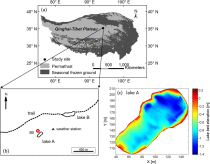多年冻土是青藏高原水文循环的重要组成部分,其变化强烈影响着高原径流特征和湖泊水量平衡。在气候变暖的影响下,青藏高原冻土区面积减少,活动层厚度增加。同时高原中部许多湖泊扩张迅速,湖泊扩张机理一直存在争议。目前已有不少学者利用大尺度遥感观测和模型模拟等手段对青藏高原一些较大的湖泊进行了研究,认为主要由降水增加所致。由于这些湖泊多处于多年冻土区,除了缺乏常规的实地观测资料(入湖径流、湖面降雨及蒸发等)外,与之密切相关的多年冻土的退化及其水文效应还不清楚。因此,揭示冻土水文过程与湖泊水量平衡的关系对深入认识湖泊扩张机制具有重要的意义。
针对这一科学问题,我室潘喜才研究员在前期利用探地雷达发现多年冻土层上水对热融湖塘的补给机制的基础上,近期进一步利用实地水文观测和水平衡模型刻画了热融湖塘的主要水文过程及其在不同降水年份的水文响应特征。研究发现非结冰期降水导致的冻土层上水补给量是直接降水补给量的1.7倍,而且该补给量随着降雨量的增加呈显著的非线性增加趋势。该结果表明,青藏高原冻土区一些湖泊的扩张除了由直接降水增加的贡献外,还有降水导致的冻土层上水补给增加的显著贡献。这一研究成果为认识高原湖泊变化提供了新的视角,并提醒我们未来需要重视多年冻土的变化及其降水产流的机制变化。以上研究成果近期发表于Journal of Hydrology。
Xicai Pan,Qihao Yu,Yanhui You,Kwok Pan Chun,Xiaogang Shi,Yanping Li. Contribution of supra-permafrost discharge to thermokarst lake water balances on the northeastern Qinghai-Tibet Plateau. Journal of Hydrology,2017,doi.org/10.1016/j.jhydrol.2017.10.046
Abstract
The seasonal hydrological mechanisms of two thermokarst lakes on the northeastern Qinghai-Tibet Plateau (QTP) were characterized by three-year intensive field observations and a water balance model. In three ice-free seasons, the supra-permafrost discharge contributed a mean ratio of over 170% of the precipitation. In the ice-cover seasons, the supra-permafrost discharge contribution varied between -20% and 22% of the water storage change. Results show that a large portion of the lake water storage change is because of the supra-permafrost discharge resulting from precipitation. Furthermore, a precipitation-subsurface runoff function is preliminarily identified in which the supra-permafrost discharge nonlinearly increased with more precipitation. Our results show that the recent lake expansion is linked with increasing supra-permafrost discharge dominated by precipitation. This study also suggests that we need to pay attention to the nonlinear increase of precipitation-controlled supra-permafrost discharge on the large lake expansion at the catchment scale in the QTP region, instead of only looking at the inputs (e.g., precipitation and river discharge) as shown in the previous studies.








